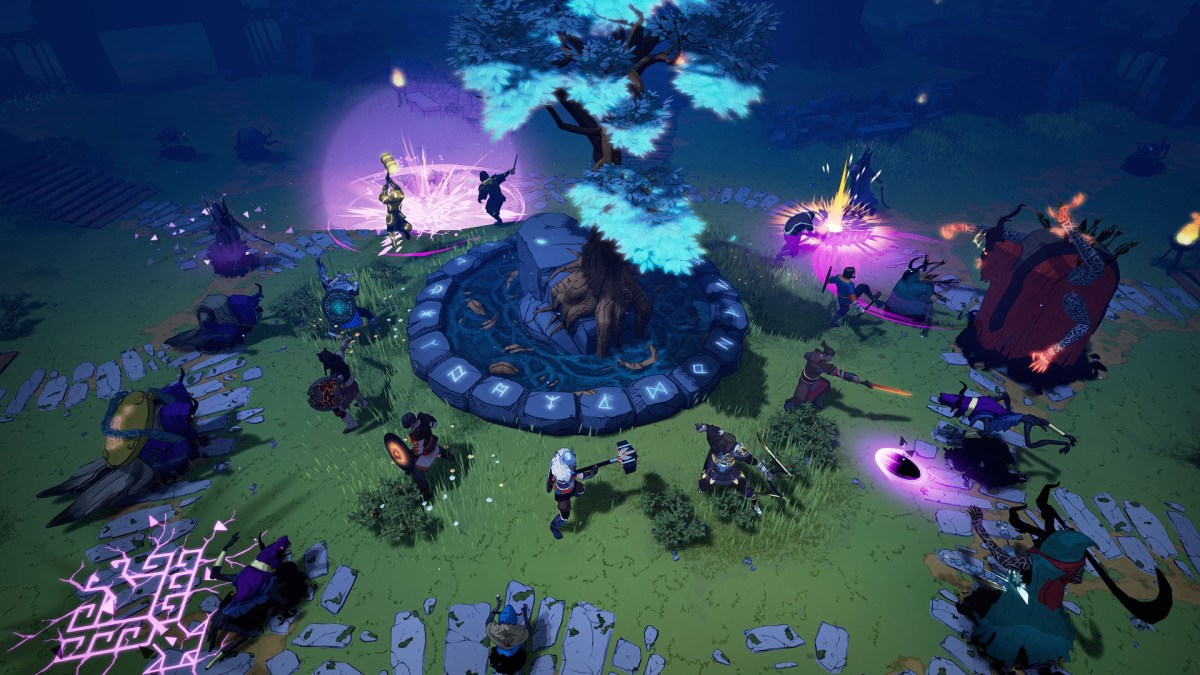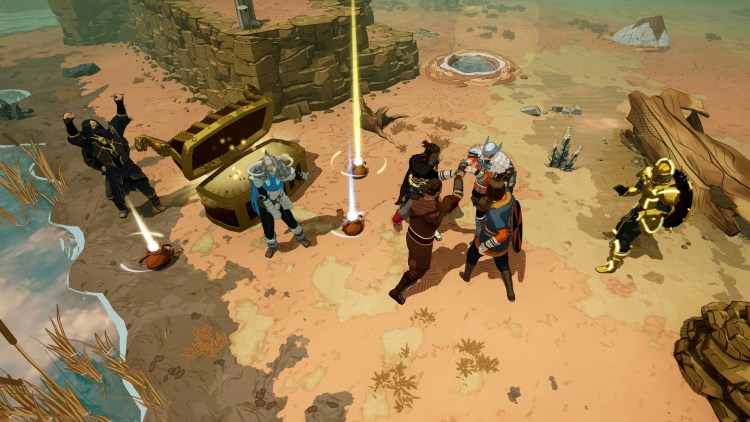I have to admit that I was excited when I first heard about Tribes of Midgard. I’ve been a long-time fan of action role-playing games (ARPGs). I poured so many hours into Valheim, a survival game where you play as a Viking. Now, imagine these two concepts, an ARPG and a Viking survival game, merged into one.
Indeed, Tribes of Midgard already had the right ingredients. Unfortunately, this mish-mash of genres is dragged down by questionable design flaws and a rather off-putting pacing. It led to a point when I could hardly find a reason to continue.
The coming of Ragnarok
Tribes of Midgard doesn’t really have a story. Its sandbox campaign, Saga Mode, lets you create a Viking character with limited customization options. Then, you’re dropped on a vibrant world that’s teeming with life. Given the concept of procedural generation, the maps (based on random seeds) tend to be different in each subsequent run. Combined with the environments and biomes, one can easily say that Tribes of Midgard has a unique charm. Its bright and vivid visuals blend well with the cartoony design, creating an appealing experience.
You start out by picking up flint and branches, and upgrade your gear at the NPCs in your village hub. Next, you acquire tools to help mine ores and cut down trees. You need to gather up resources for crafting and construction purposes. Then, the day turns into night within five minutes of starting your campaign. At night, enemies known as Helthings start spawning near your village. Their target is the world tree, Yggdrasil, and its destruction will mean the end of your world and an abrupt game over.
You and the villager NPCs band together to stop your foes. Once the dust has settled, you’ll continue farming for more stuff to prepare for eventual assaults. Also, your character picks up “souls” whenever you kill enemies or gather resources. This currency is used to upgrade NPCs, purchase certain items, construct important fixtures, or heal Yggdrasil when necessary.
Likewise, since Tribes of Midgard is partly an ARPG, you possess several skills depending on the weapons that you’re using (i.e., ground smashes, fire trails, whirlwind slashes, or projectile hits). Additionally, you can unlock classes and skills to bolster your capabilities.
Taking down the giants
On the second day, you’re warned that a Jotunn has appeared on the map. This lumbering giant will slowly make its way to your village in its attempts to consume Yggdrasil. As such, your short-term goal is to scout ahead. Once you find the Jotunn, you’ll whittle down its health until it’s barely a threat when it manages to reach your hub.
Jotnar (the plural of Jotunn) are powerful creatures. These beings are massive, easily dwarfing your character (their full models won’t even fit on your screen). They also have special attacks, such as lightning strikes, flaming stomps, and self-healing quirks.
More Jotnar will spawn as you continue onward with your campaign, at times coinciding with the arrival of Helthings. These battles are quite the spectacle, and the challenge is enough to keep you on your toes.
Pacing problems in Tribes of Midgard
Unfortunately, most of the positives in Tribes of Midgard are just on the surface. Its core gameplay loop leaves a lot to be desired primarily due to its pacing. For reference, a normal run would begin as mentioned earlier (i.e., gathering materials, upgrading weapons, acquiring tools, leveling up your villager NPCs, and beating the Helthings/Jotnar that arrive). Past that point, you need to quickly look for features related to the main quest.
At one point, you have to find a bridge that leads to another zone, only to realize that you need several materials and thousands of souls to repair it. While doing this, you also have to complete quests, limited-time random events, and hideout treks to acquire fragments. These fragments are required to unlock Fenrir’s lair.
As someone who mostly played solo, this laundry list of tasks was downright mind-boggling at first. To top it all off, the challenge ramps up as the days progress. You’ll encounter Blood Moons, where Helthings are nastier and more numerous. Then, before two weeks of in-game time has passed, you’ll experience the Fimbulwinter. This endless winter and long night entails countless Helthings that your own villagers won’t be able to handle.
Needless to say, it’s going to be hard to keep up. You really won’t know where to start, and you’ll probably fail a few times before you get a hang of things. Still, even if your run ends, you might acquire boosts or starter gear from the game’s season pass/battle pass system.
A mish-mash of genres
Tribes of Midgard initially intrigued me based on its premise. Yes, it’s a bit like an ARPG owing to the combat. But, it’s not a “loot grind/loot farm” where you keep most of the stuff you collect during a run. Once you abandon your world, see it destroyed, or use the Bifrost to leave, you’ll only retain your season pass/battle pass progress and Golden Horns (a currency for cosmetics or rune drops). One can even consider these rogue-lite facets in the game. However, unlike actual rogue-lite games (i.e., Hades, Risk of Rain 2, and many others), you don’t necessarily feel that you’ve advanced further. You’re likely to choose from unlockables such as starter gear or mining/woodcutting tools, and that’s that.
Moreover, I initially thought that Tribes of Midgard had Valheim vibes with Viking characters and the Norse Mythology-inspired setting. It even has survival, crafting, and building mechanics. Sadly, it’s more like a tower defense game. At best, you’ll build the quarry and fortify the village’s gates to fend off mobs. It’s not like visiting someone else’s realm to admire their work. Oh, and to make matters worse, your character, a damned Viking, can neither swim nor climb ledges. If there’s a ledge that you can’t reach, you need to buy and place wooden ramps. You could also get stuck, forcing you to initiate your character’s death, losing all souls in the process. Oh, and if you so much as go wade into a body of water, you’re dead as well.
I started from scratch in each subsequent Tribes of Midgard run (akin to survival games). Still, I was at the mercy of pacing and RNG map generation. If I couldn’t find the bridge, the hideout was too far, or I couldn’t get to an event location in time, I needed to rush. Once Fimbulwinter set in, I was hard-pressed to battle Fenrir while trying to ensure that my village and Yggdrasil were well-defended. Playing solo definitely meant poor pacing.
What else can you look forward to in Tribes of Midgard?
I played a few extra Saga Mode campaigns, and I beat my previous record (my personal best is a Day 8 clear). Then again, I’m not a speedrunner and I don’t need the bragging rights (i.e., get a Day 4 or Day 5 clear), so this goal was pointless. In the multiplayer games I’ve played (a system that supports a group of up to 10 players), there were hardly any interactions. Most of us knew what we were doing, so we just ran off separately to complete the objectives as fast as possible. As such, I had to ask myself what the purpose of this whole endeavor was.
In the end, I truly wondered if there was anything else to look forward to in Tribes of Midgard. Was I just trying to unlock additional season pass ranks by replaying the same process over and over? Was I just doing this to clear Saga Mode a bit faster?
Don’t get me wrong, Tribes of Midgard does have its appeal. Maybe those who have friends actively playing it often will enjoy it more. Regrettably, as a predominantly solo player, this mish-mash of genres and mechanics led to an offering that is less than the sum of its parts. Still, if ever you decide to pick it up, you can always check out our guides and features hub to help you on your journey.













Published: Aug 5, 2021 11:30 am